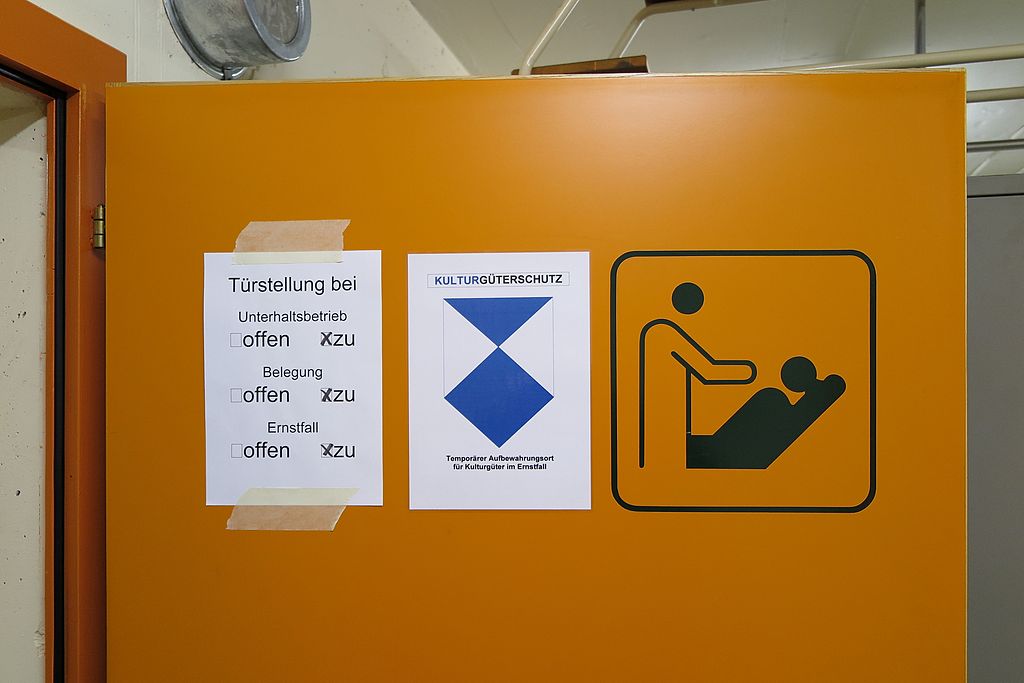- Version
- Download 7214
- File Size 1.12 MB
- File Count 5
- Create Date 9 June 2022
- Last Updated 28 January 2024
Safe Havens, Refuges and Evacuation
What's the difference between refuges, safe havens and shelters?
Shelter
The term shelter is used interchangeably in these contexts to mean a general storage facility for moveable cultural property that is endangered by crisis, disaster, or conflict.
Refuge
A refuge is a term used in the 1954 Hague Convention for the Protection of Cultural Property in the Event of Armed Conflict.
Article 1: "For the purposes of the present Convention, the term `cultural property’ shall cover, irrespective of origin or ownership: [...] [b] buildings whose main and effective purpose is to preserve or exhibit the movable cultural property defined in sub-paragraph (a) such as museums, large libraries and depositories of archives, and refuges intended to shelter, in the event of armed conflict, the movable cultural property [of great importance]".
It is a facility that stores - or is intended to store - moveable cultural property " of great importance" endangered by conflict in the territory of a state party to the 1954 Hague Convention. It qualifies as cultural property under the Convention and is entitled to the general protection of respect. It may be marked with a blue shield, and may be registered for special or enhanced protection by the State Party if they choose.
There are no legal requirements on the storage conditions inside the facility, but the drafters of the Convention expected refuges to be ‘fitted out by the State for this specific purpose. These shelters should be specially built to protect the property against bombardment, and fire or against dryness and damp’ (in Toman, 1996).
Safe Haven
A safe haven has no fixed definition. In general, they are designated facilities to store moveable cultural property endangered by conflict or disaster. Very few countries have laws to regulate them, though there are international guidelines, and some institutional, or field-specific guidelines. In most laws and guidelines, it is assumed that the cultural property will be from a source country, and stored in a third party country away from danger, but some documents refer to domestic safe havens. They qualify for legal protection under the 1954 Hague Convention if:
- the safe haven property itself qualifies as immovable cultural property of great importance;
- the movable objects inside qualify as cultural property of great importance; or
- the safe haven intends to shelter such movable cultural property in the event of an armed conflict.
Safe havens are often viewed as a form of legal international assistance under the 1999 Second Protocol.
The venue requirements in safe haven laws and guidance are stringent. Facilities should:
- have adequate climatic, security, and technical conditions to guarantee state-of-the-art safekeeping;
- be bombproof;
- be well managed.
Due to the legal complexities (safe havens may requirement some form of diplomatic relations, bi-lateral agreement, or MoU between states and / or institutions) safe havens have rarely been used. One of the most successful examples is the Afghan Museum in Exile.
Resources
Refuge and Safe Haven Guidelines
OA - Association Of Art Museum Directors. Protocols For Safe Havens For Works Of Cultural Significance From Countries In Crisis, September 28, 2015
OA - Guidelines for the Establishment and Conduct of Safe Havens as Adopted by the International Law Association at its 73rd Conference held in Rio De Janeiro, Brazil, 17–21 August 2008. (2009). International Journal of Cultural Property, 16(4), 371-378. doi:10.1017/S0940739109990300 (Kindly made open access by IJCP).
OA - Wenk, T., and Giovanni, A. (2024). Cultural property shelters: construction of new refuges and repurposing of decommissioned protected facilities. Protection of Cultural Property Section, Swiss Federal Office for Civil Protection
OA - 2020. Kulturgüterschutzräume Und Notfallplanungen Abris pbc et planifications d'urgence Rifugi pbc e piani d'emergenza (PCP Shelters and Emergency Planning. PCP Forum 35 (in Swiss, can be translated using Google?).
Evacuation Guidelines
OA - BSI - When should you evacuate your collections. A Conflict Guide. Available below in English and Ukrainian.
ICCROM - Endangered Heritage: Emergency Evacuation of Heritage Collections - Available on the ICCROM website in English, French, Arabic, Turkish, Portuguese, Ukrainian, Nepali, Georgian, Japanese, Turkish, Farsi, Italian, Russian , German
Academic articles
OA - Jakubowski, A. (2019). International Protection of Cultural Heritage in Armed Conflict: Revisiting the Role of Safe Havens. Indonesian Journal of International Law 16 (2). DOI: 10.17304/ijil.vol16.2.748. Available at: https://scholarhub.ui.ac.id/ijil/vol16/iss2/2
NOT OA - Pollard, N. (2020) Refuges for movable cultural property in wartime: lessons for contemporary practice from Second World War Italy, International Journal of Heritage Studies 26(7), 667-683, https://doi.org/10.1080/13527258.2019.1678052
NOT OA - Siehr, K. (2006). "Chapter Seventeen ‘Safe Havens’ for Endangered Cultural Objects". In Art and Archaeology of Afghanistan. Leiden, The Netherlands: Brill. doi: https://doi.org/10.1163/9789047418351_023
NOT OA - Paumgartner, N., & Zingg, R. (2018). The Rise of Safe Havens for Threatened Cultural Heritage. International Journal of Cultural Property, 25(3), 323-346. https://doi.org/10.1017/S0940739118000188
NOT OA BUT the book is available as a low cost pdf with editors discount at this link. - Cunliffe, E., and Fox, P. (eds) (2022) Safeguarding Cultural Property and the 1954 Hague Convention. All Possible Steps. Suffolk: Boydell Press.
Contains several relevant articles:
- Philip W. Deans, P.W. (2022) Protective Measures Before the 1954 Hague Convention: The Case of the Imperial War Museum, 1933–1950. pp 57-77
- Paumgartner, N., & Zingg, R. (2022). Refuges, Safe Havens, and the Protection of Movable Cultural Heritage, pp. 79-98
- Albisetti, L., and Büchel, R. (2022). Cultural Property Shelter Systems: The Swiss Model, pp. 205-218
Attached Files
| File | Action |
|---|---|
| Swiss Shelter Section - Cultural property shelters 2024-en.pdf | Download |
| ILA - Guidelines for establishment and conduct of safe havens.PDF | Download |
| AAMD Save Haven Protocols 10 1 15 (2).pdf | Download |
| SwissPeace - Guiding Principles for Safe Havens for Archives at Risk A Commentary. International Working Group on Safe Havens.pdf | Download |
| Jakubowski - International Protection of Cultural Heritage in Armed Conflict - revisting safe havens.pdf | Download |


